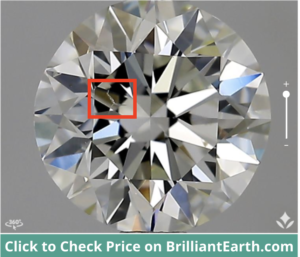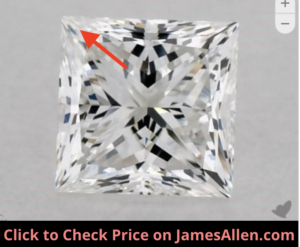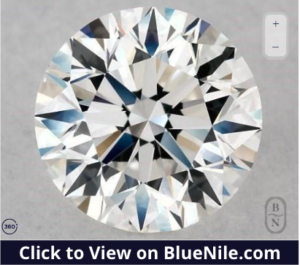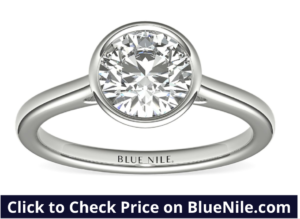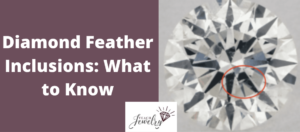
Diamond inclusions are imperfections that affect its appearance, durability, and light performance.
One of the most common inclusions is a diamond feather.
We’ll explore what feather inclusions are, how they impact overall quality and performance, identifying them in a grading report, and more.
What is a Feather Inclusion?
A feather inclusion is a fracture, break, or crack inside a diamond that has a feathery appearance. They’re often white or black and vary in their size and position.
If you’re examining a diamond feather under a microscope, the fissure appears as a jagged line.
Check out this image of a one-carat round-cut diamond at 10x magnification, and try to spot the feather.
The report shows it’s located toward the middle of its table.
The translucent color isn’t always apparent, but if you rotate the stone at multiple angles, it will appear more prominently from certain views.
Feathers can be found on the upper half or lower half of a diamond or even break through the girdle.
Feathers inclusions aren’t formed because of a hit or drop. Instead, they develop during the formation of the diamond or when it was pushed to the surface.
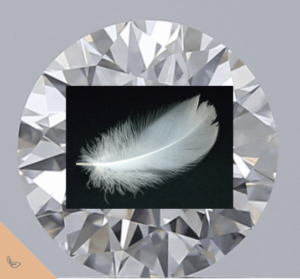
This is true of all inclusions.
The extent to which feathers impact the overall aesthetic and light performance of the diamond is dependent on size, color, and location.
How do Diamond Feathers Affect Brilliance?
Brilliance refers to how well diamonds return white light, which gives it the desirable brightness and sparkle.
All inclusions affect brilliance because they cause light to exit the diamond from the sides or bottom instead of the top.
Feather inclusions affect brilliance, but knowing just how much it’s impacted requires details on the specific gem.
For example, an excellent cut diamond with a few instances of small, translucent feathers would have better light performance than the same cut with several large, dark feathers.
The bigger and darker the feathers are, the more they diminish brilliance.
To provide an actual example, check out the diamond below with an excellent cut.
I’ve highlighted the noticeable feather in the middle of the table. Even though it has a quality cut, I recommend avoiding one with a feather in that position.
But if you choose a diamond with excellent cut, you don’t have to worry as much about minor occurrences of feathers.
On the other hand, a diamond with a fair or good cut already lacks the glimmer of higher quality diamonds, so combining those cuts with feathers could result in a dull diamond.
Do Feathers Cause Durability Issues?
One of the main concerns about feathers in a diamond is the fractures can cause durability issues. Even though diamonds are rated a 10 on the Mohs scale, giving them the title of Earth’s hardest naturally-occurring substance, they can still chip.
The situation to be concerned about is when there’s a large feather located in or near the girdle of the diamond.
The girdle is the perimeter that separates the top from the bottom.
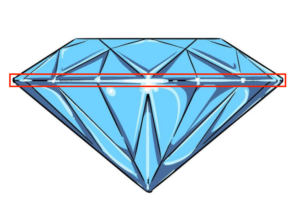
In that case, it’s more prone to chipping when it experiences significant impact to a hard surface.
The girdle is often the weakest point on the diamond. If it’s already fragile because of feathers, it could break with one final hit.
The other cause for concern is when the feathers are near the pointed edges.
These areas are more susceptible to chips, so any damage already there adds to the risk of those edges breaking off.
For example, it’s best to avoid princess, trilliant, and baguette cut diamonds with feathers close to the corners. These areas are the most likely to chip when hit on a hard surface, so that weakness would be multiplied with feathers there.
To illustrate, I’ve highlighted the pointed corners on the princess cut below.
If the clarity characteristics plot showed a feather there, I would avoid it.
How Do Feathers Impact Clarity?
A diamond’s clarity is graded according to the number, type, and visibility of inclusions. A diamond with a VS2 clarity or higher is generally “eye-clean,” meaning the naked eye can’t see any inclusions.
That includes feathers, so if you buy a diamond that’s at least an VS2 clarity, you won’t see them without a microscope.
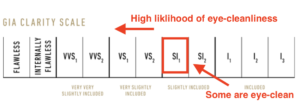
This is considered the sweet spot for finding a valuable diamond. You’ll pay higher prices for clarity grades closer to flawless, but most diamond buyers aren’t concerned with its appearance under a microscope — only to the naked eye.
So earning a discount with a diamond closer to SI1, such as one with feathers, can give you a clean diamond without a significant price increase.
Here’s an example of a 0.75-carat diamond that likely meets that criteria.
But just because they aren’t visible to the naked eye doesn’t mean feathers have no impact on clarity.
The presence of feathers result in a lower grade from evaluating organizations and lessen its overall value.
If there are multiple large feathers, the clarity grade will be lower, especially if they’re in prominent locations.
This could result in an I1, I2, or I3 grade, which means they’ll be visible to naked eye and significantly affect its clarity and appearance.
How to Identify Feathers in Diamond Grading Reports
The GIA and AGS are considered two of the most credible organizations for assessing diamonds. Their evaluations come with a grading report that explains the quality of the diamond, including a clarity plot that shows where inclusions are located.
As an example, the GIA provided a report on this 1.50-carat round cut diamond.
The “Clarity Characteristics” section shows the diamond has feathers on the lower part, several of which approach the girdle.
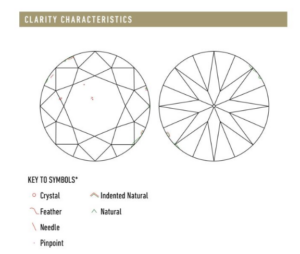
Based on this report, and the diamond’s SI1 clarity grade, you could conclude the feathers wouldn’t be visible to the naked eye and wouldn’t cause durability concerns.
Even though they approach the girdle, they’re small enough to where they likely wouldn’t cause it to chip, were it struck against a hard surface.
And because it has a very good cut and is graded near colorless, you’d expect this diamond to have some shine, even if it doesn’t have the best light performance.
In addition to considering the size and placement of feathers in the grading report, also check girdle thickness.
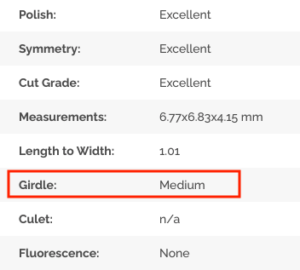
If it’s labeled extremely thin to slightly thin, as opposed to medium to extremely thick, that’s another indicator feathers near the girdle could cause problems.
Can They be Removed or Hidden?
Feathers can sometimes be seen with the naked eye, so you might wonder if there’s a way to simply remove them.
The process of removing imperfections from a diamond is called clarity enhancement. Fractures, including feather inclusions, are filled, so they’re no longer visible to the naked eye.
It isn’t always successful because glass-like resin used to fill the cracks sometimes appears like air bubbles or scratches.
Another downside to removing feathers though clarity-enhancement is a poor job can result in even more durability issues. So while this method can result in a more eye-clean diamond, pursue it with caution.
A safer way to hide feathers is through your choice of setting. If the feathers are on edges of the diamond, choose a bezel setting that covers the outside or a prong setting where they’re placed over the imperfections.
Here’s an example of a diamond ring with a bezel setting that would hide feathers on the outer edge.
As long as they aren’t in positions that could cause durability challenges, this is an effective solution.
Should You Buy a Diamond With Feathers?
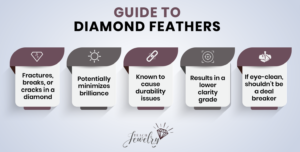
Don’t avoid a diamond simply because it has feathers. There’s more to consider than just their presence, such as size, position, color, and impact on appearance and light performance.
If you’re searching for a diamond close to one carat, consider clarity grades of VS2 or higher and an excellent cut. You’ll have confidence any feathers are invisible to naked eye, and it’ll still have strong brilliance.
There are also some SI1 diamonds that meet this standard.
Your goal is to strike the balance between avoiding premium prices for high clarity grades but also ensuring imperfections like feathers don’t impact its appearance to the naked eye.

Jacob Clarke
Jacob Clarke is the founder of TeachJewelry.com.
He earned an Applied Jewelry Professional Diploma from the Gemological Institute of America (GIA) and now brings you essential information about diamonds, settings, and more.
Jacob has consulted with leading jewelry brands, and his work has been cited in Clean Origin, Diamond Nexus and industry publications.
He's also a member of the International Gem Society.
He enjoys discussing jewelry with readers, so contact him with any questions at jacob.clarke@teachjewelry.com.

